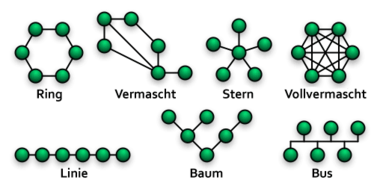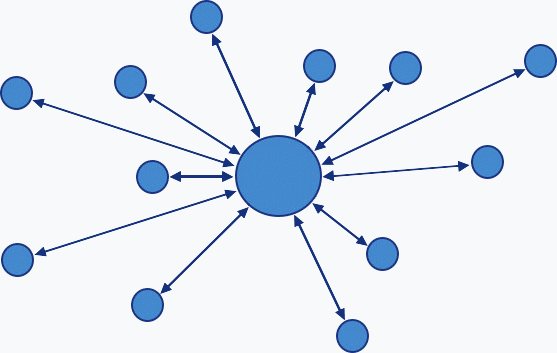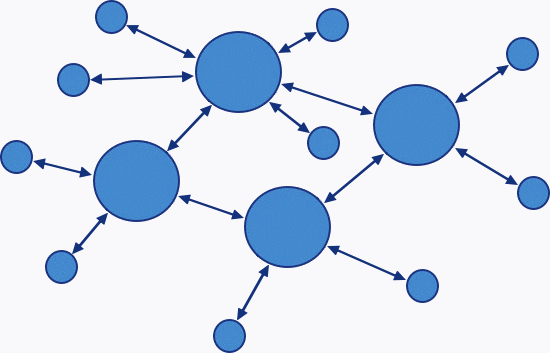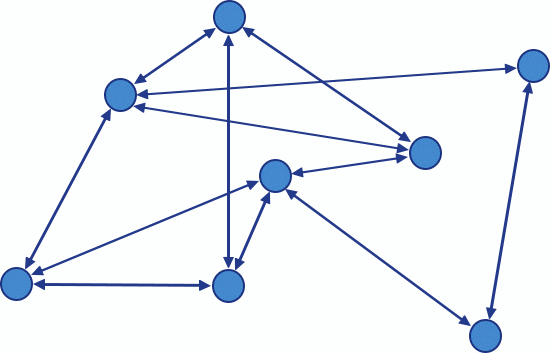Network structures
| |
Differences
The word “network” refers to the technical connection between different participants. Technically there is a multiplicity of possible networks, which occur also mixed:

Basically, the following differentiation of messenger systems is made into three different network structures:
Central systems = star-shaped networked
Federal systems = federally networked
Distributed systems = meshed networking (direct connections)
Central messenger systems
There is a central data center where all data of all users is stored, maintained and made available:

Examples
Prominent examples of messengers each running their own network and cutting themselves off from others:
- WhatsApp
- Company: WhatsApp Inc., Menlo Park, USA
- Server location: USA
- Wikipedia: https://de.wikipedia.org/wiki/WhatsApp#Geschichte (external)
- Telegram
- Company: Team / Dubai, Vereinigte Arabische Emirate
- Server location: worldwide / not defined
- Wikipedia: https://de.wikipedia.org/wiki/Telegram#Geschichte_und_Hintergründe (external)
- Threema
- Company: Threema GmbH, Zürich, Switzerland
- Server location: Switzerland
- Wikipedia: https://de.wikipedia.org/wiki/Threema#Entwicklung (external)
- Signal
- Company: Open Whisper Systems, San Francisco, USA
- Server location: USA
- Wikipedia: https://de.wikipedia.org/wiki/Signal_(Messenger) (external)
Federal messenger systems
There is not just one data center, but several/many/numerous. Data storage is distributed among the participating subnetworks and is therefore decentralized.

Examples
Examples of federated messenger networks with messengers that are open:
- XMPP
- Company: - none, because free network protocol and international standard (IETF)-
- Server location: - countless, free (libre) -
- Messaging apps/programs: many different
- Wikipedia: https://de.wikipedia.org/wiki/Extensible_Messaging_and_Presence_Protocol (external)
- Matrix
- Company: - none, because free network protocol -
- Server location: - many, free (libre)-
- Messaging apps/programs: many different
- Wikipedia: https://en.wikipedia.org/wiki/Matrix_(communication_protocol) (external)
Distributed messenger systems
Decentralized, meshed networks result from direct connections between different users without intermediate servers.
Connections are made only between equally authorized participants in the network.

Examples
Examples of meshed (computer-to-computer) networks with messengers that are all independent of any central authority:
- Briar
- Company: - keins, da freies Netzwerkprotokoll -
- Server location: - no server -
- Wikipedia: https://de.wikipedia.org/wiki/Briar_(Instant_Messenger) (external)
- Wikipedia: https://de.wikipedia.org/wiki/Vermaschtes_Netz (external)
- Jami
- Company: - none, because free network protocol -
- Server location: - no server -
- Wikipedia: https://en.wikipedia.org/wiki/Ring_(software) (external)
- Tox
- Company: - none, because free network protocol -
- Server location: - no server -
- Messaging apps/programs: different
- Wikipedia: https://de.wikipedia.org/wiki/Tox_(Protokoll) (external)
Special knowledge: Network protocols
In every network, the rules for data exchange must be defined. There are protocols that specify exactly this. An overview of various protocols can be found here:
https://de.wikipedia.org/wiki/Liste_von_Instant-Messaging-Protokollen (external)
https://en.wikipedia.org/wiki/Comparison_of_instant_messaging_protocols (external)